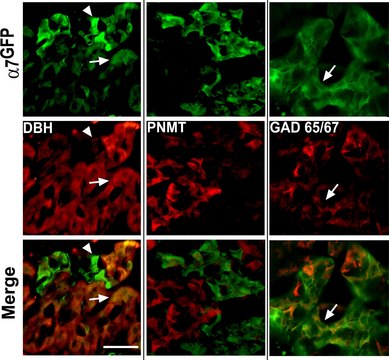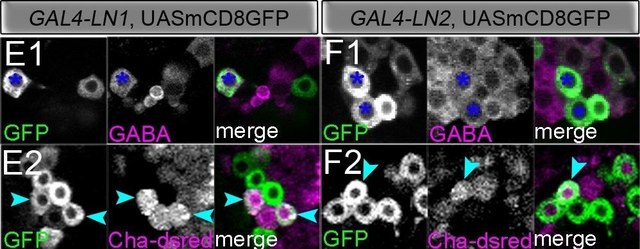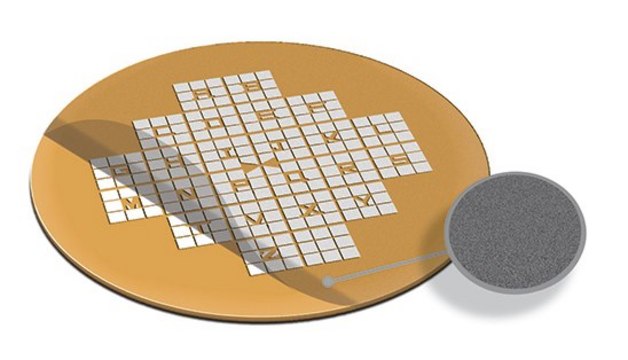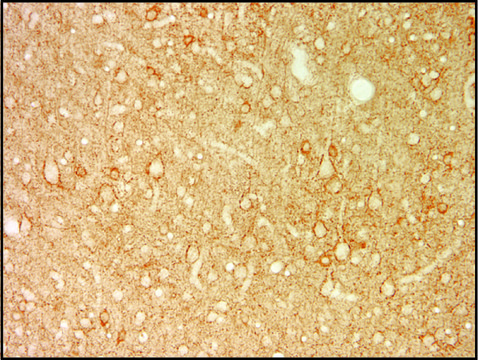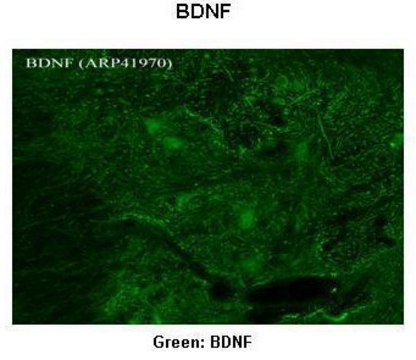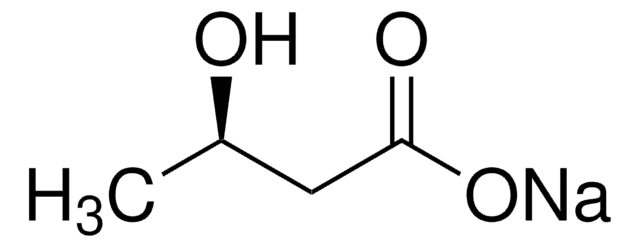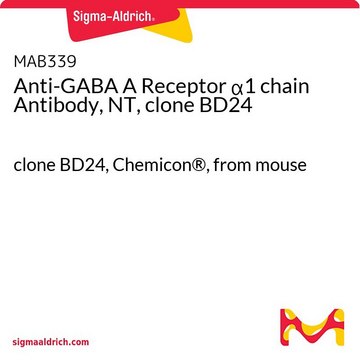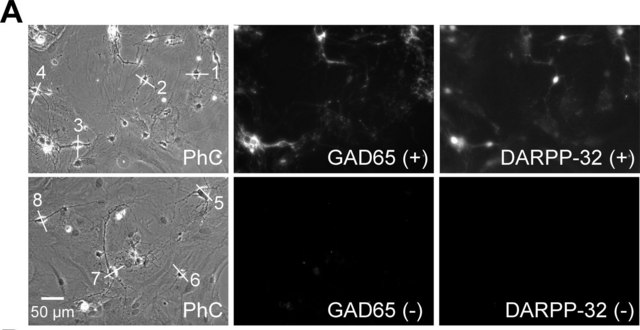推荐产品
产品名称
抗-GAD 65/67, from rabbit, purified by affinity chromatography
生物来源
rabbit
质量水平
抗体形式
affinity isolated antibody
抗体产品类型
primary antibodies
克隆
polyclonal
纯化方式
affinity chromatography
种属反应性
rat, mouse, human
包装
antibody small pack of 25 μg
技术
immunohistochemistry: suitable (paraffin)
western blot: suitable
同位素/亚型
IgG
NCBI登记号
运输
ambient
靶向翻译后修饰
unmodified
基因信息
human ... GAD1(2571) , GAD2(2572)
一般描述
谷氨酸脱羧酶2/谷氨酸脱羧酶1(UniProt:Q05329/Q99259;又称65kDa/67kDa谷氨酸脱羧酶,GAD-65/67,谷氨酸脱羧酶65/67kDa亚型)由人的GAD2/GAD1(又称GAD65/GAD67)基因编码(基因ID:2571)。谷氨酸脱羧酶亚型在大脑中表达,参与γ-氨基丁酸(GABA)的合成。谷氨酸脱羧酶2也在胰腺组织中表达。GAD65和GAD67都在细胞的不同位置和不同的发育阶段合成GABA。通常,GAD1在整个细胞中均匀分布,而亚型GAD2主要位于神经末梢。GAD1合成GABA用于神经元活动,该活动与突触发生和神经损伤保护有关。然而,GAD2亚型合成GABA用于神经传递活动。
特异性
该兔多克隆抗体可检测人,小鼠和大鼠中的GAD2和GAD1。它靶向C末端区域14个氨基酸内的表位。
免疫原
KLH偶联线性肽,对应于人谷氨酸脱羧酶2(GAD2)C末端区域的14个氨基酸。
表位:C端
应用
免疫组化分析:代表性批次的1:1,000稀释液在人小脑,小鼠大脑皮层和大鼠大脑皮层组织中检测到GAD 65/67。
抗GAD 65/67抗体,目录号ABN904是一种高度特异性的兔多克隆抗体,可靶向人,小鼠和大鼠GAD2和GAD1,并已在免疫组化(石蜡)和蛋白质印迹中进行了测试。
研究类别
神经科学
神经科学
质量
通过蛋白质印迹对人脑组织裂解物进行了评估。
蛋白质印迹分析:2 µg/mL的该抗体可在10 µg人脑组织裂解物中检测到GAD 65/67。
蛋白质印迹分析:2 µg/mL的该抗体可在10 µg人脑组织裂解物中检测到GAD 65/67。
目标描述
观察值~60/62kDa;GAD2和GAD1计算值分别为65.41/66.90 kDa。在某些裂解物中可以观察到未鉴定的条带。
外形
亲和纯化
纯化的兔多克隆抗体,溶于含有0.1 M Tris-甘氨酸(pH 7.4)、150 mM NaCl和0.05%叠氮化钠的缓冲液中。
储存及稳定性
自发运之日起,在 2-8°C 条件下可稳定保存1年
其他说明
浓度:请参考特定批次的数据表。
免责声明
除非我们的产品目录或产品附带的其他公司文档另有说明,否则我们的产品仅供研究使用,不得用于任何其他目的,包括但不限于未经授权的商业用途、体外诊断用途、离体或体内治疗用途或任何类型的消费或应用于人类或动物。
未找到合适的产品?
试试我们的产品选型工具.
储存分类代码
12 - Non Combustible Liquids
WGK
WGK 1
闪点(°F)
does not flash
闪点(°C)
does not flash
K P Briski et al.
Brain structure & function, 226(4), 1053-1065 (2021-02-14)
Recurring insulin-induced hypoglycemia (RIIH) in males correlates with maladaptive glucose counter-regulatory collapse and acclimated expression of ventromedial hypothalamic nucleus (VMN) nitric oxide (NO) and γ-aminobutyric acid (GABA) metabolic transmitter biomarkers, e.g., neuronal nitric oxide synthase (nNOS) and glutamate decarboxylase65/67 (GAD).
Md Main Uddin et al.
ASN neuro, 13, 17590914211035020-17590914211035020 (2021-10-02)
Brain glycogen is remodeled during metabolic homeostasis and provides oxidizable L-lactate equivalents. Brain glycogen phosphorylase (GP)-brain (GPbb; AMP-sensitive) and -muscle (GPmm; norepinephrine-sensitive) type isoforms facilitate stimulus-specific control of glycogen disassembly. Here, a whole animal model involving stereotactic-targeted delivery of GPmm
Karen P Briski et al.
Acta neurobiologiae experimentalis, 80(1), 57-65 (2020-03-28)
The catecholamine norepinephrine (NE) links hindbrain metabolic‑sensory neurons with downstream gluco‑regulatory loci, including the ventromedial hypothalamic nucleus (VMN). Exogenous NE up‑regulates VMN expression of glutamate decarboxylase (GAD), biomarker for the gluco‑inhibitory transmitter γ‑aminobutryic acid (GABA). Brain glycogen phosphorylase (GP)‑muscle (GPmm)
Khaggeswar Bheemanapally et al.
Scientific reports, 11(1), 16079-16079 (2021-08-11)
Astrocyte glycogen, the primary energy reserve in brain, undergoes continuous remodeling by glucose passage through the glycogen shunt prior to conversion to the oxidizable energy fuel L-lactate. Glucogenic amino acids (GAAs) are a potential non-glucose energy source during neuro-metabolic instability.
Abdulrahman Alhamyani et al.
AIMS neuroscience, 8(4), 510-525 (2021-12-09)
Gamma-aminobutyric acid (GABA) acts on ventromedial hypothalamic targets to suppress counter-regulatory hormone release, thereby lowering blood glucose. Maladaptive up-regulation of GABA signaling is implicated in impaired counter-regulatory outflow during recurring insulin-induced hypoglycemia (RIIH). Ventromedial hypothalamic nucleus (VMN) GABAergic neurons express
我们的科学家团队拥有各种研究领域经验,包括生命科学、材料科学、化学合成、色谱、分析及许多其他领域.
联系技术服务部门